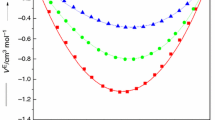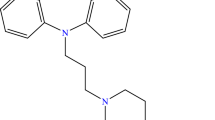Abstract
In the present investigation, an attempt has been made to apply the methods of classical chemical kinetics to the hydrolytic reaction of pipethanate hydrochloride. By successively keeping all but one variable essentially constant, it has been possible to resolve the overall effect of the individual contributing factors. Since nearly all commercial pipethanate preparations are formulated with antacid, studies were made at several constant hydrogen ion concentration ranging pH 0.4 to 7.5. Rate measurement was also carried out in temperature ranging from 25°C to 60°C. The hydrolysis of pipethanate is found to be of first order with respect to pipethanate concentration over an experimental range of hydrogen ion concentration (pH 0.4–7.5). The apparent activation energy(Ea) at pH 7.5 is 18.30 Kcal/mole and the frequency factor is 1.1408×109 sec−1. The rate of the hydrolysis has a minimum at pH 2.5–3.5. In this region the half-life of pipethanate was about 15.3 days at 60°C. The catalytic effect of water was found to be\(K_{H^{ + } } = 1.1568 \times 10^{ - 2 } min^{ - 1} \) at 60°C. The catalytic constants of the hydroxyl ions and hydrogen ions at 60°C were also found to be\(K_{OH^ - } = 4.5519 \times 10^5 min^{ - 1} \) and\(K_{H_2 O} = 3.16 \times 10^{ - 5} {\text{ min}}^{{\text{ - 1}}} \), respectively. This reaction appears to be primarily base catalyzed hydrolysis and pipethanate is relatively reluctant toward acid catalyzed hydrolysis. A positive primary salt effect was noted in the solution of pipethanate at pH 7.5 and at 60°C.
Similar content being viewed by others
Literature cited
Clake, E. G. C.,Isolation and Identification of Drugs, Pharmaceutical Press, p505 (1971).
Lespagnol, A., Laude, M., and Lemoine, J. P., Quaternary methiodides of substituted aminoethyl-benzilates,Bull. Soc. Pharm. Lille., 109 (1962).
Lemoine, J. P., Parasympathetic and antispasmodic agents, Fr. M3354(Cl. A61K, C07cd), July 12, 1965.
Kawashina, K., Tanaka, S., Nakamura, S., Nagao, S., Kdwamura, T., Omoli, Y., and Sarrazin, G., Pharmacological effect of pipethanate I.-effect of pipethanate on central nervous system.Eisei Shikenjo Hokoku,89, 50 (1971).
Tanaka, S., Kawashina, K., Nakamura, S., Nagao, S., Kuwamura, T., Omori, Y., and Sarrazin, G., Pharmacological effect of pipethanate II.-effect of pipethanate on respiration, circulation system and smooth muscle,ibid,89, 54(1971).
Higuchi, T., Havinga, A., and Busse, L. W., The kinetics of the hydrolysis of procaine.J. Am. Pharm. Asso. Sci. Ed.,38, 405(1950).
Finholt, P., and Higuchi, T., Rate studies on the hydrolysis of niacinamide.J. Pharm. Sci.,51, 655(1962).
Winderheuser, J. J., and Higuchi, T., Kinetics of thiamine hydrolysis.J. Pharm. Sci.,51, 354 (1962).
Matsuura, I., and Kawamata, M., Studies on the prediction of shelf-life I.-prediction with an analog computer.Yakugaku Zassi,95(11), 1255 (1975).
Castellan,Physical Chemistry, Addison-Wesley, p464 (1966).
Author information
Authors and Affiliations
Rights and permissions
About this article
Cite this article
Kim, CK., Cha, H.S. Stability of pipethanate hydrochloride in aqueous solution. Arch. Pharm. Res. 4, 109–115 (1981). https://doi.org/10.1007/BF02855753
Received:
Issue Date:
DOI: https://doi.org/10.1007/BF02855753




